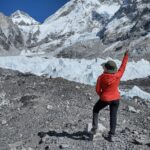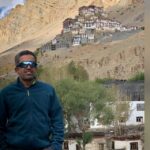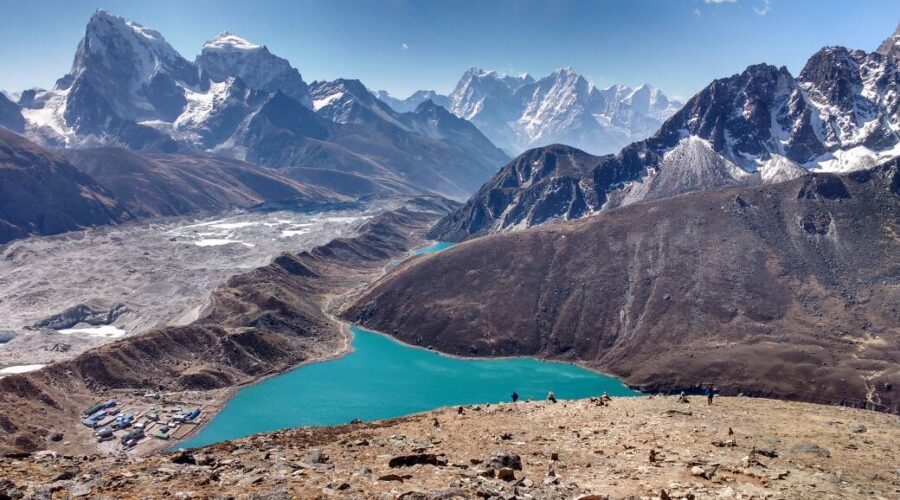Everest Base Camp Trek via Gokyo Lakes is a more rewarding trek to the base camp of the highest mountain in the world. To truly do justice to trekking in the Everest region, Everest Base camp- Gokyo Ri circuit is the trek to do! This trail offers you the best of both worlds: the well-trodded Everest region and the lesser crowded Gokyo region. With just three more days to the itinerary, the journey becomes more rewarding.
The views from the Gokyo Ri summit are much beautifule and grander than the ones you will see from on top of Kala Patthar . From Kala Patthar, you would see three of the 14 eight-thousanders in the world – the Everest, Makalu and Lhotse. From the Gokyo Ri summit, you not only see these mountains but also see another eight-thousander, Cho Oyu. Cho Oyu, the sixth highest mountain in the world.
Price Includes
Price Excludes
Everest Base Camp Trek via Gokyo Lakes is once in a life time experience. You get to visit the base camp as well as beautiful Gokyo lakes. Everest Base Camp lies in the northeastern part of the Khumbu region of Nepal. Trekking in the Everest region offers you a lifetime memorable moment where you will experience local Sherpa culture, and traditions as well as magnificent views of the world’s highest peaks including Mt. Everest, Lhotse, Cho-Oyu, Nuptse, Pumori, Amadablam, Island peak, Thamserku, and mighty of peaks.
Fly to Kathmandu and transfer to hotel. Meet our trek leader and other members. Kindly ensure that you arrive at Kathmandu before afternoon o so you can rest well before next day departure to Lukla and have enough time to do any last time preparations. Overnight at hotel.
.
We will start early morning and we will be travelling from Kathmandu to Ramachep airport for an early morning flight to Lukla (2,800m). After a thrilling 20 minute flight, we reach the Tenzing-Hillary Airport at Lukla.. Upon arrival at Lukla, we meet our other crew members, and after some packing and arrangements, we start our trek from Lukla to Phakding
Today trail takes us along the Dudh Koshi River through many suspension bridges, one of which is the famous Hillary Suspension Bridge. First, we catch the wonderful glimpse Mt. Thamserku (6,618 m). We will cross the small villages of Benkar, Chumoa, and Monjo, we will reach the check post and entrance to Sagarmatha National Park. We pass through the last village of Jorsale before reaching Namche Bazaar. From Jorsale the trail climbs through the forests until we reach the confluence of the Dudh Koshi and Bhote Koshi rivers. After a final steep ascent of about two hours, we get the first view of Mt. Everest. We will take rest here to admire the view. We still need to hike about 1.5 hours to reach Namche Bazaar, a gateway to Mt. Everest and the main trading centre of this region.
Namche Bazaar is the capital of the Khumbu region. You will get the first Everest Viewpoint. You will be trekking through Sagarrmatha National Park. There are lots of shops in Namche Bazaar. One can buy souvenirs on the way back.
Today will be our first of the two days set aside for “acclimatization.”. We hike to Everest viewpoint and will come comeback to Namche Bazaar and it will take 3-4hrs .Namche Bazzar is the main centre of the Everest (Khumbu) region and has government offices, ATMs, Internet cafes, shops, restaurants, a bakery, and a colourful market.
The day starts with a climb up from the Namche bazaar before reaching Kyangjuma , a small village offering spectacular views of mountains all around you. As we leave Kyangjuma the trail gradually rises up leading us up to Mongla, a small collection of tea houses with breathtaking views of snowcapped peaks all around.
Today after breakfast we descend down toward the Dudh Kosi and later follow the river towards its source. The trail gradually gains altitude and is more isolated often passing through rich section of birch, fir and rhododendron forests, leading us to a small place with few tea houses, Dole.
The trail starts with a steep uphill climb from Dole to Lahframa and further to Luza (4360m), from Luza the trail gets easier passing through many small villages and summer settlements of the villagers. Once again following the valley high above the Dudh Kosi towards it source we come across a small settlement of few tea houses known as Machhermo, our destination for the day.
Today’s trail follows a climb from Machhermo. After reaching Phangka (4480m) the valley widens and we have to descend towards the river before climbing the steep trail that leads us to the terminal moraine of the Ngozamba glacier. After climbing up the moraine for few minutes we are welcomed by an old iron bridge that marks our entry to the Gokyo lake valley. A gentle trail leads us to the first lake of the valley, Longpongo. At a small distance lies the second lake Taboche tso, connected through a stream to the Dudh Pokhri, the third lake and on the bank of the lake lies Gokyo a small village and our destination for today.
The highlight of our trek – the Gokyo Ri stands tall across the Dudh Phokri. Early morning we follow the trail that leads up to the summit of Gokyo peak or the Gokyo Ri. It is a 2-3 hour steep climb to the top but truly rewarding. Once described as the best view point in Nepal Himalaya, the summit of the Gokyo Ri truly offers such a panorama of the mighty Himalaya that we can hardly believe we are not dreaming. Surrounding us are Kusum Kanguru (6367m), Cho Oyu (8153 m), Gyangchung Kang (7922m), Lhotse (8501m), Makalu (8475 m), Cholatse (6440m), Taweche(6542m), Kantega (6685m), Thamserku (6808m), Lobuche (6145m) and Mt Everest (8848m) and hundreds of other unnamed peaks. Later we descend down to Thangnak.
We start early in the morning to catch the beautiful views from Kala Patthar. However, we need to prepare for an early morning departure, amid predawn darkness and cold temperature (-10 to -14 C).
Further, there is always the potential for chilly winds which are quite common. Familiar peaks such as Lingtren, Khumbutse, and Changtse tower to the east even as Everest begins to reveal itself. During the ascent to Kala Patthar, we can pause to catch a breath at several outstanding viewpoints from where we can snap great pictures. After several hours of ascent, we reach Kala Patthar. From Kala Patthar, we scramble up to the top of a rocky outcrop marked by cairns and prayer flags. Mind-blowing Himalayan panorama unfolds before our eyes as they wander
Return to Gorak Shep and after breakfast trek back to Periche
We will start our day early for Cho La Pass. It is going to be a long day.
Cho La Pass is right behind Thangna. The ascent, which is quite a climb, has a lot of rubble and scree. The descent is tricky with a snowed out glacier and boulders. Stick to the right of the glacier and follow the guidelines strictly. Don’t venture on your own. Depending on the situation of the ice, crampons will be used.
After the boulder patch which is hard on your knees, it is a steep descent to Dzongla.
The 3-hour walk to Labouche is mostly on a flat trail but you will be walking at quite an altitude. You’ll come across a junction where the trail splits into Pheriche and Labouche. Take the left. Views of Ama Dablam will accompany you till this point.
Around 90 minutes before Labouche, you’ll meet trekkers going on the traditional Everest highway. Helicopter sorties are commonplace here
It takes about 3 hours to reach Gorakshep, which is a very busy place. You’ll see the terrain change as you approach the place. There are a lot of trekkers coming in. You’ll see Everest Base Camp on the trail to Gorakshep.
After early lunch at Gorakshep, set off for EBC. Make sure you carry your day pack since you’ll need water. The climb is fairly moderate, though the moraines are slippery and the ridge bordering Khumbu glacier is very windy.
Everest Base Camp provides a very unique experience since you’ll see potential summiters. The climbers’ tents look striking against the backdrop.
Please note: drinking water at Gorakshep is chargeable. 1 litre of drinking water costs 350 Nepalese rupees. This is not included in the trek fee. Non-potable water is available free of cost – if you’re carrying a water purifying bottle, you could consider using that instead
We will sstart early for Kala Patthar so that you reach in time to watch the sun rising over the peaks. Kala Patthar is the highest point of the trek.
From the summit, you’ll get great views of Everest, South Col – the traditional route to Everest summit. You will even be able to identify Hillary’s steps.
There are great views of Lhotse, Makalu, the Khumbu glacier and icefall, and of the entire Everest Base camp. Pumori is straight ahead from the summit.
After spending some time at Kala Pathar, return to Gorakshep and start for Pheriche immediately after breakfast. Retrace the route back to Labouche, from where it’s another 3 hours to Pheriche.
You’ll cross Dughla/Thukla where there are memorials of mountaineers who died climbing Everest.
Pheriche is a village situated above the Tsola river. It is extremely picturesque and surrounded by mountains. There is a hospital in Pheriche, which was specially set up for the benefit of trekkers, and is currently run by the Himalayan Rescue Association with the help of volunteers from all over the world
Today will be a long day. We will start for Pheriche a bit early. On the way we will stop at Tengboche to visit the monastery. After Tengboche there is steep descent till river and then steep ascent till Kyangjuma before we reach Namche Bazar.
Again this will be a long day. It will be a steep descent for initial 3hrs. We will reach Phakding and from there it will be a gradual ascent till lukla
If flight is to Ramechhap we will drive to Kathmandu for 4hrs.
One of the most popular treks in the world is trekking to Everest Base Camp, which offers the most exhilarating and memorable experience of all. You get to see the highest mountains of the mountains. And reaching the base of the Everest is one of the life time achievements.
As you land in Lukla so you will immediately feel the difference in the air temperature. Once you reach Dingboche the temperature will drop. And continue dropping the higher you go. During the winter, the temperature can go down to -20 Celsius at night.
There are two seasons for the Everest Base Camp. One is late Sep-Nov and another is Feb-May.
These are the main trekking months with fairly stable conditions, good visibility and temps at Base Camp getting up to about -6°C.
The difficulty level of Everest base camp trek in moderate to Difficult. But it’s not a technical climb and if you’re fit enough, mentally and physically, you’re more than likely to be up to the challenge. This is a difficult trek at altitude and over at least 10 days.
You should start your physical preparation at least 3 months ahead of your climb. If you do not have access to hills and mountains, then you need to focus more on the strength and conditioning for the trek to Everest Base Camp.
Unlike other treks in Nepal, you are allowed to trek to Everest Base Camp without a guide. Though, you can trek to Everest Base Camp alone, we recommend hiring local guides. Not only does this support a vital industry, but it also gives you the local insight to make the trip so much better and safe. And you don’t have to worry about booking the tea houses on the way
Most of the tea houses on the trek have WIFI facility. But you have to pay for using the WIFI facility. The speed is not so good. It is good enough to send WhatsApp messages.
You will get the cell coverage in Everest Base Camp Trek. The service will not be available in all the areas, you will get the network at different areas throughout the Everest Base Camp trek. NCell and Nepal Telecom works best in Everest region.
You won’t see the Everest summit from the base camp .Some of the best viewpoints are Everest View Hotel, Kala Patthar.
Weather plays a very big role in the running of this trek. Flights to Lukla are a fair-weather friend. A cloud covering a mountain ridge can shut down the entire airport! Hence, we suggest keeping a buffer day.The buffer day can be handy in case the weather goes bad during the trek or the team needs an extra rest day.
Bottled water can be purchased at most tea houses and shops along the route. Because of the altitude, it is recommended you drink in the region of 3-4 litres per day, although this can include tea and soup. We recommend using Lifestraw bottle. It will save you a lot of money because the higher you go the higher the prices for the bottled water.
Most the tea houses on the Everest base Camp trek have charging facility. But you have to pay to avail this facility.
Yes, there is a facility to keep your extra luggage at Kathmandu. You keep it at the hotel where you will be staying.
8699488862
info@eskapetrails.com
Had a great experience on my EBC trek with Eskape trails. Everything was organized well for the trekker’s. The knowledge of the guide on the trails made us relax & be confident on reaching the base camp. Entire team was flexible for trekkers need, ensuring we were comfortable & healthy during the trek. Really happy to choose Eskape trails for this adventure & looking forward for the next.

I went on a customized EBC trip in Oct 2023. Nitin, a founding member of Eskape Trails happens to be my Junior from IIM Indore. His team was proficient in creating a custom trek plan for us. The quality of the accommodation on the trek was top-notch.

I had the privilege to trek with Gurdit from Eskape Trails. I was part of the group led by him, and can say he was an excellent leader. The Entire Trek was well planned and executed. The quality of the Tea Houses and the food served was Top notch. I highly recommend the team for EBC Trek

I recently embarked on the adventure of a lifetime, the Everest Base Camp (EBC) trek, and it wouldn’t have been the same without the exceptional guidance and companionship of Gurdit from Eskape Trails, our amazing trek leader. Thank you, Eskape Trails, for sharing and making this adventure truly remarkable!.

Everything was just perfect from stay to food to trek lead to transportataion….We had a great time

Fill out the form below, our Trek Lead will be in touch shortly.

